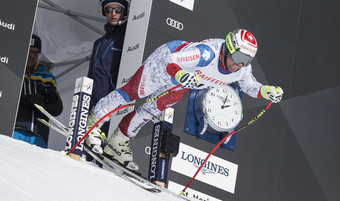How Do You Currently Do Your Race Start
- STEP OUT - Step start, simply stepping out the start gate one foot at a time.
- Pros: Little effort required.
- Cons: Slow start as first leg to move trips wand and time starts before other foot has left start position.
- PUSH START - Simple push start, push out using backward thrust of arms to push feet forward.
- Pros: Clean away, usually in balance, easy safe start for novice racers.
- Cons: Not much power and speed through wand and into course, need to get arms back to a forward balanced position quickly.
- JUMP START - Twin foot heels up jump, assisted by forward push from arms.
- Pros: Clean start, can be powerful and fast, good balance in to course.
- Cons: Needs all round body strength and co-ordination, need to get arms back to a forward balanced position quickly.
- SLIDE START - Slide skis forward from stationary position using backward thrust from arms to slide skis and feet forward.
- Pros: Moderate start speed, Clean start, in balance, good for non-lead out dual slalom starts as no time wasted going backwards before going forward.
- Cons: Needs lots of arm strength and coordination to generate speed, need to get arms back to a forward balanced position quickly.
- STAMPER - One leg stamp, immediately followed with twin foot forward jump assisted by backward thrust from arms projecting feet forward.
- Pros: Similar to JUMP START but uses stamp as a trigger for the twin foot jump phase.
- Cons: Can prematurely hit wand in start gate and set timer off.
- SLIDER - Slide skis back, then fire feet and skis forward using backward push from arms
- Pros: Can generate a lot of speed.
- Cons: Needs a lot of core strength and coordination from back, abdominals and arms, can slide back too far out of range for optimum power, can be tricky when ski surface is slippery or sticky.
- ROCKER - Keeping skis stationary, rock upper body back beyond a squat position, fire upper body forward followed by backward pull through from arms.
- Pros: A lot of speed can be generated.
- Cons: Can be out of balance when leaving the start gate and have problems recovering balance and establishing early line. Can have problems with catching wand with poles.

A More Effective Way To Start
- Plan your movements ahead so that your are focusing on setting up your start for a good entry in to the first gate.
- Place your boots just behind but not touching the start wand with enough room to allow you to flex your boots without hitting the start wand.
- Place your ski pole tips on the other side of the start wand. Hold your poles tightly and correctly on the handles, shoulder width apart.
- Within the time allowed (5 seconds) after the command of the starter or the starting system beeps jump the tails of your skis upwards by straightening your legs quickly and powerfully and allow your upper body to tilt forward taking some weight on your ski poles. Allow your body to move forward supported by your ski poles. Keep your arm movement inline from the forward position of your shoulders driving backwards, i.e. do not allow your hands to collapse inwards or stray outwards. Make sure there is only a forward movement of the upper body, i.e. you are not accidentally jumping upwards.
- When your body is forward of the start wand push back on your poles by straightening the arms keeping to drive the upper body and accelerate forward through the start wand. Ensuring the arm motion remains line with your shoulders through this power move. More experienced racers may push their legs back exaggerating the forward motion of the upper body even more before the boots open the start wand. There is no upward movement of the body, except for the feet, when the feet push back.
- Skate and push hard with your poles. Raise your chin to see the course and watch for soft snow on the sides of the starting area to prevent catching your edges.
- Remember to have in mind a good visual of the direction of travel required in order to setup the amount of attack for the first turn in to the first gate.
- Think of the above as being a series of interlinked phases in order to eliminate any stops or pauses in momentum.